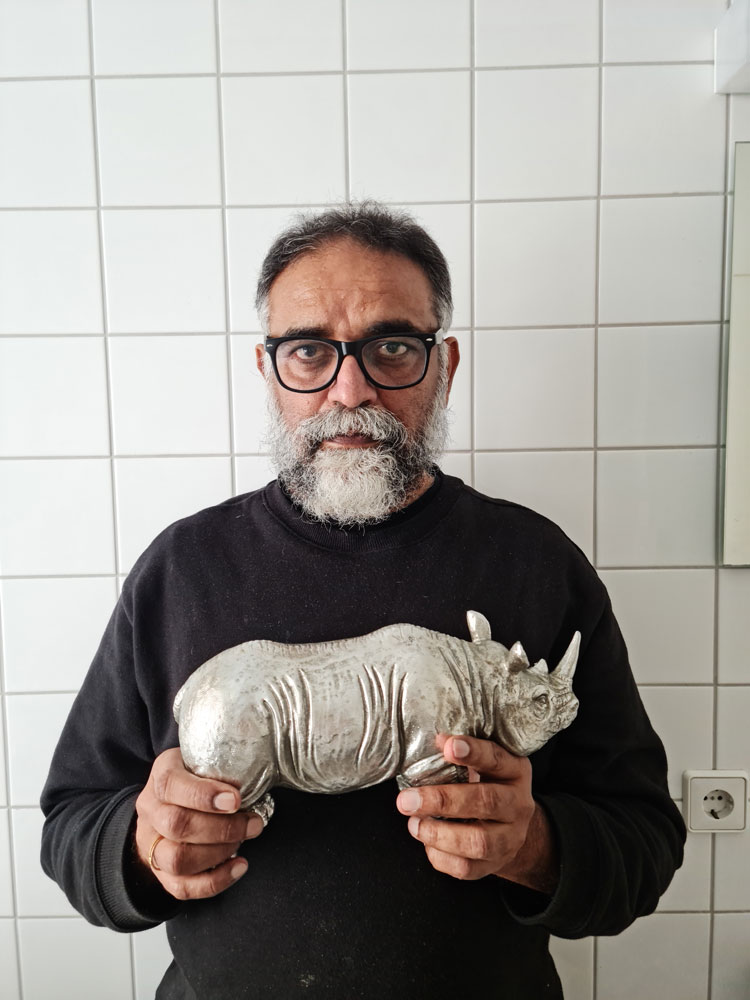LECTURE
on Thursday, March 14, 2024 at 7 pm a lecture with Aymeric Hainaux will take place in the Lichtenberg Studios.
Aymeric Hainaux is this year’s guest artist of the cooperation with DIEresidenz from France.
Beatboxer, comic author, visual artist and poet – Aymeric Hainaux is a “total artist”. Hainaux likes to go for walks a lot: He observes the earth and his natural surroundings in a poetic context. The independent artist celebrated his first artistic successes when he self-published works such as Melancholia and initiated an almost seven-year tour of hitchhiking performances on three continents. He is the founder of the group Cantenac Dagar and has been expressing himself through a very personal beatboxing practice for twenty years.
As a visual artist, Hainaux creates land art sculptures and installations as well as extremely precise abstract drawings.
Lecture
Suresh Jayaram
Suresh Jayaram
This narrative is a collage of incidents that took me to different places in Berlin and was
absurd. Hence, all these incidents were like images, objects, and historical facts that inspired
me to connect the dots. It was like a giant jigsaw puzzle of the Rhinoceros that had many
fragments to be put together. The leitmotif of these multiple narratives is about the bitter-
sweet global transactions and the representation of the Rhino in retrospect, which gives the
reader a train of thought and a roller coaster ride. I call the Indian Rhino -Maya after an
Indian restaurant across from my studio, which was a former pub for Neo Nazis, and the
narrative unfolds across continents and transcends time and space.
This locality, which was part of the former GDR, has a history. I sought the Rhinoceros with curiosity through the lens of
art and history, from the archive of following the creature through history and its representation. It is a collection of incidents from the facts in this complex world of human
transactions filled with desire and loss, fear and hope.
I discovered the Rhinocerous as an exotic
aesthetic object, as a motif. It was nurtured in the zoo as a tropical, dark, dangerous, and
fearsome creature from India. But the pachyderm’s fragile existence as a keystone species
on this planet makes it an endangered species. Rhinos are targeted for their horns and
perpetuate a chain of violence as humans victimize and hound their existence. This story is
inhuman and brutal.
Rhinos are creatures closely associated with the elements of earth and water. They exude
massive energy but are grounded with an aura of being solitary, meditative, and mindful. An
animal that is best left to itself and has a majestic air about it, like the elephant – aggressive
only if triggered by human interference. We often view the Rhino within the zoo captivity or
on a safari that evokes a sense of awe, curiosity, and fear with a large dose of exotic Zoo
architecture that transports one to another artificial landscape. It is a showcase for tourists of
the wild in a staged stereotypical environment. From the top of the pyramid, we must capture
animals and house them in zoos. Like the art that is savored in museums but does not
belong there. We need a holistic and responsible strategy with the wild, not Disneyland.
Albrecht Durer’s Rhinoceros:
He was (1471-1528, gifted, versatile, and the most prominent Renaissance artist, known as
an incomparable painter and draftsman with a keen eye for the natural world. He was also
known for his greatest impact on printmaking. His print, in focus, is considered the essential
image of an animal for many reasons and represents a Rhinoceros. In the year 1515, Durer
embarked on making an image of it.
In retrospect, Dürer’s passion for the natural world was evident in his early work. His ability
to create black-and-white graphic images that could be circulated was path-breaking. As the
pioneer of artistic printmaking aesthetics and economy, the power of this single unique two-
dimensional work of the Rhino created a new kind of circulation and ownership which also
dismantled the aura of a singular work of art.
Interestingly, Dürer himself never saw an actual rhinoceros. Dürer’s Rhinoceros, as it came
to be known commonly, was an image based on a written description and a brief sketch of
Maya the Rhino by an unknown artist. As its fame spread, Dürer drew the image we know,
combining invention, folklore, and idiosyncratic zoology in a fantastical creature that
surpasses any observational study of the animal, and has become a highly influential image
in its own right. This woodcut recorded the exotic creature’s arrival in Europe to King Manuel’s
menagerie in Lisbon.

